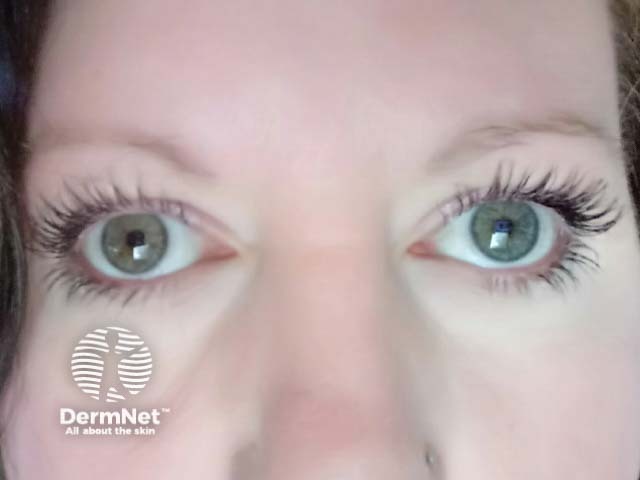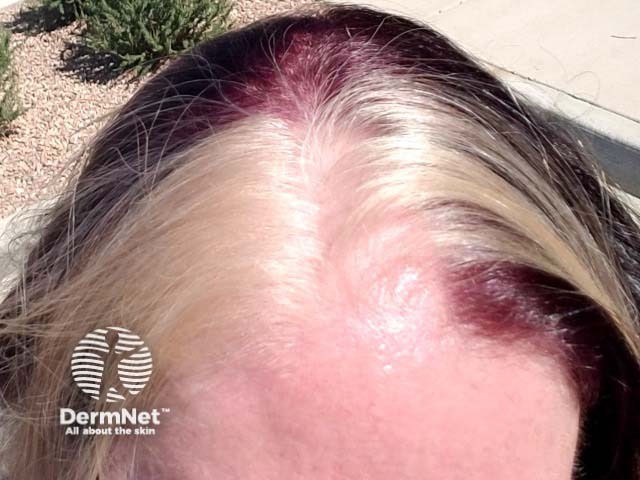Main menu
Common skin conditions

NEWS
Join DermNet PRO
Read more
Quick links
Author: Dr Dominic Tabor, Dermatology Registrar, Royal Infirmary of Edinburgh, Scotland. Chief Editor: Dr Amanda Oakley, Dermatologist, Hamilton, New Zealand, October 2015. DermNet Revision August 2021
Introduction Demographics Causes Clinical features Diagnosis Treatment Outcome
Waardenburg syndrome is a rare genetic disorder characterised by sensorineural hearing loss and pigmentary abnormalities of the hair, skin, and eyes.
Waardenburg syndrome is named after Petrus Johannes Waardenburg, a Dutch ophthalmologist, who noticed that heterochromia iridis often accompanied deafness.

Heterochromia iridis

White forelock
Waardenburg syndrome may be inherited or new mutations can arise spontaneously. It affects males and females equally, and can affect all races.
It has a population frequency of 1 in 40,000, and is responsible for 2–5% of all cases of congenital deafness.
Waardenburg syndrome is a neurocristopathy due to gene mutations which result in abnormal neural crest differentiation during embryonic development.
Mutations in a number of different genes can cause Waardenburg syndrome, with some differences in symptoms and signs. Expression and penetrance are also variable.
The mutations that cause Waardenburg syndrome include insertions, deletions, frameshifts, splice alterations, missense, or nonsense mutations.
Most types of Waardenburg syndrome are autosomal dominant, meaning that only one affected gene needs to be passed on to a child for them to have the syndrome. Transmission of defects in EDN3 or EDNRB is more complex; they are usually autosomal recessive, although cases of autosomal dominant transmission with incomplete penetrance have been described.
Other mutations in some of the above genes can cause related clinical syndromes, such as Tietz syndrome (MITF gene), piebaldism (SNAI2 gene), PCWH (SOX10 gene), or ABCD syndrome (EDNRB gene).
Features are present from birth. As it is a rare condition and clinical signs can be subtle, diagnosis may not be made until later in life. In addition to the characteristic pigment changes and deafness, Waardenburg syndrome can be associated with musculoskeletal defects and Hirschsprung syndrome.
Four major clinical types of Waardenburg syndrome have been identified.
Type 1 is the most common subtype of Waardenburg syndrome. Features include:
Type 2 has similar clinical features to type 1 Waardenburg syndrome, but the inner canthi are normal.
Type 3 (Klein-Waardenburg syndrome) also has similar features to type 1 Waardenburg syndrome, but with musculoskeletal abnormalities, such as muscle hypoplasia, flexion contractures, or syndactyly (fused digits).
Type 4 (Shah-Waardenburg syndrome) has similar features to type 2 Waardenburg syndrome but with Hirschsprung syndrome (a condition resulting from missing nerve cells in the muscles of part or all of the large intestine).
Waardenburg syndrome is diagnosed on clinical features. In 1992 the Waardenburg Consortium developed major and minor criteria for diagnosis.
A clinical diagnosis of type 1 Waardenburg syndrome needs 2 major, or 1 major and 2 minor criteria.
The W index can be calculated to determine whether dystopia canthorum is present.
Genetic sequencing of the PAX3 gene for mutations causing Waardenburg syndrome may be performed as part of genetic counselling of family members. Prenatal testing for PAX3 mutations is possible by chorionic villus sampling or amniocentesis, but is rarely done due to the clinical variation found within Waardenburg syndrome and the mutation will not indicate which clinical features will be present or their severity.
As Waardenburg syndrome is a genetic disease there is no curative treatment. Genetic counselling may be helpful for affected patients who want to start a family.
The clinical features of Waardenburg syndrome are stable and the features will remain throughout life. Life expectancy is normal.